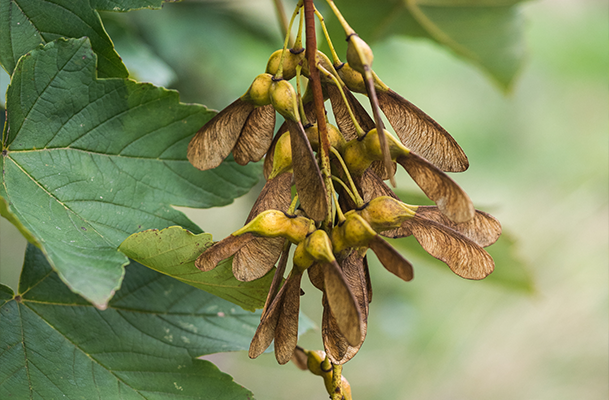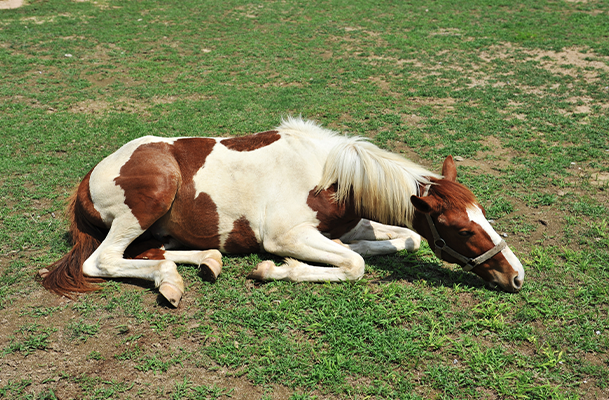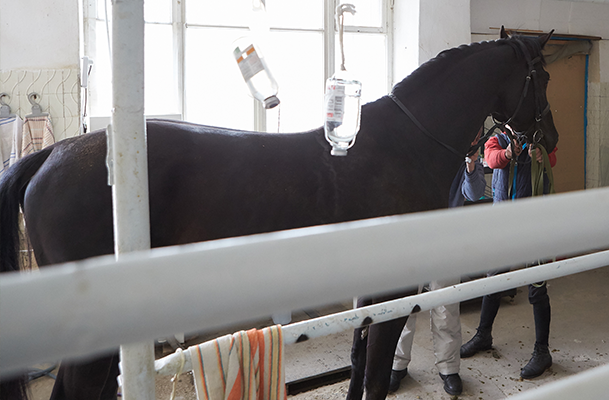La myopathie atypique est une forme de rhabdomyolyse non traumatique. C’est une pathologie rare, mais souvent fatale pouvant affecter les chevaux. Elle ne semble pas affecter les autres membres de la famille des équidés, cependant, les raisons derrière cela ne sont pas encore établies.
Bien que les premiers cas recensés en Europe remontent à plusieurs dizaines d’années, ce n’est qu’en 2014 que le lien avec les graines et les jeunes pousses d’Acer pseudoplatanus (érable sycomore). Cette maladie est due à l’ingestion de samares, les graines en ‘hélicoptère’ du sycomore ou de plantules. Son effet est dévastateur si elle n’est pas diagnostiquée et traitée à temps. D’après le Royal Veterinaty College de Londres, la myopathie atypique est fatale dans environ trois quarts des cas. Si aucune mesure n’est prise dans les 24 à 72 heures, cette pathologie tend à être fatale.
Avec l’arrivée de l’automne, le risque de myopathie atypique augmente. Voyons ensemble les causes, les symptômes, les traitements et les mesures que vous pouvez prendre pour prévenir la myopathie atypique.
Bon à savoir :
Tous les sycomores ne sont pas porteurs de la toxine et cela peut varier d’une année à l’autre.
1. Quelles sont les causes de la myopathie atypique ?
La myopathie atypique est principalement causée par l’ingestion des samares, plantules, feuilles ou de l’écorce d’arbres appartenant à la famille des Acers, aussi connu sout le nom de sycomore. Les graines, en particulier celles tombées dans les pâtures et cachées dans l’herbe peuvent présenter un danger.
Bon à savoir :
En Europe, le risque de myopathie atypique est lié à l’Acer pseudoplatanus alors qu’aux Etat Unis, il est lié à une autre variété de sycomore, l’Acer negundo.
La toxine responsable de la myopathie atypique est l’hypoglycine A. Elle est produite par l’arbre pour le protéger contre les herbivores et les maladies.
Lorsque la toxine est ingérée, elle affecte le métabolisme et entraîne une chute de l’énergie à disposition des muscles. Les symptômes principaux en résultant comprennent lésions musculaires et défaillances multiviscérales.
 Feuilles et graines de Acer pseudoplatanus (érable sycomore)
Feuilles et graines de Acer pseudoplatanus (érable sycomore)
2. Quels sont les symptômes de la myopathie atypique ?
Un diagnostic précoce est indispensable à la réduction du risque de décès. Un éventail de symptômes est visible chez le cheval ayant ingéré des samares.
- Faiblesse musculaire : Myopathie signifie littéralement maladie du muscle. Sans surprise, les chevaux affectés par cette pathologie montrent des signes de faiblesses musculaires. Il leur est difficile de se tenir debout et de se déplacer.
- Urine foncée : Le traitement par les reins de la myoglobine (protéine du muscle) passant dans la circulation sanguine entraîne une coloration brune de l’urine.
- Augmentation de la fréquence cardiaque et respiratoire : Cette augmentation est le résultat du stress, de la douleur et de l’inconfort dans lequel se trouve le cheval.
- Léthargie : Puisque tous les muscles du cheval peuvent être affectés, y compris ceux lui permettant de boire, manger, respirer, faire circuler le sang oxygéné à travers le corps, etc. votre cheval ressent une fatigue intense.
- Tremblement : dans certains cas, on observe des tremblements musculaires.
De nombreux symptômes sont similaires à d’autres pathologies comme la maladie du lundi, l’anémie, la colique : fatigue, fréquence respiratoire et cardiaque élevée, cheval couché, se roulant, ne s’alimentant pas ou refusant de boire. Il est important de prendre en compte les facteurs environnementaux afin de diagnostiquer rapidement la myopathie atypique.
Bon à savoir :
Il n’est pas rare que les chevaux atteints veuillent boire et manger, cependant, leur réflexe de déglutition peut être affecté par des lésions musculaires et entraînant un risque d’étouffement. Donner du foin trempé est peut-être une manière plus sûre de nourrir un cheval souffrant.

3. Quels sont les traitements de la myopathie atypique ?
Aucun traitement spécifique n’existe pour la myopathie atypique. On se concentre plutôt sur le traitement des symptômes et des complications liées à la maladie. C’est pour cela qu’un diagnostic et un traitement précoces sont cruciaux pour éviter des lésions musculaires extensives, voire fatales.
- Hydratation : Les chevaux affectés peuvent avoir des difficultés à s’abreuver. L’utilisation d’une perfusion est l’une des clés pour maintenir l’hydratation et l’équilibre électrolytique. De plus elle contribue à prévenir les lésions rénales, les reins étant affectés par le traitement de la myoglobine.
- Soutien nutritionnel : Il peut être nécessaire d’apporter l’énergie et les nutriments essentiels par voie intraveineuse ou nasogastrique.
- Gestion de la douleur : Des douleurs apparaissent lorsque les muscles se détériorent. Un traitement anti-inflammatoire est souvent prescrit pour maintenir le confort du cheval.
- Assistance respiratoire : comme tous les muscles de l’organisme, le cœur et les muscles respiratoires sont affaiblis. La mise en place d’une assistance respiratoire soutient l’oxygénation et l’irrigation des organes vitaux. Maintenir le cheval debout peut aider à minimiser le risque de défaillance respiratoire qui augmente lorsqu’il se couche.
- Observation : La surveillances des signes vitaux est cruciale. (fréquence respiratoire et cardiaque, température, saturation du sang en oxygène, etc.) Il est également important de s’assurer que le cheval est dans un lieux sûr et calme.
- Récupération: La période de récupération varie d’un individu à l’autre en fonction de l’étendue des lésions, de l’âge et de la forme du cheval. La plupart des chevaux passant le cap des 72 heures survivent. La rééducation consiste à aider le cheval à se remuscler.

4. Comment prévenir le risque de myopathie atypique chez le cheval ?
Comme nous l’avons vu plus haut, le pronostic du cheval souffrant de myopathie atypique est souvent sombre et le diagnostic complexe. Comme souvent, mieux vaut prévenir que guérir. Dans ce cas, elle consiste à bien gérer l’environnement de votre cheval, son pré et le fourrage.
- Gestion des pâturages : Si possible, évitez de donner accès à une zone où un sycomore pourrait contaminer l’alimentation. Gardez en tête que bien que la plupart des graines tombent à l’automne, la sécheresse ou le vent peuvent les faire tomber plus tôt et elle peuvent s’envoler assez loin. Pensez également aux jeunes pousses au printemps. Raccourcir le temps passé à brouter et inspecter le pré régulièrement peut atténuer les risques.
- Complémenter l’herbe : Instinctivement, les chevaux ne mangent pas les graines de sycomores, cependant, lorsque l’herbe est rase et peu abondante, ils peuvent en ingérer accidentellement. Distribuez du fourrage pour complémenter l’herbe, en évitant de le donner à même le sol pour minimiser les risques de contamination.
- Access à l’eau : Assurez-vous que votre cheval a accès à de l’eau propre. Gardez en tête que les graines d’un arbre affecté peuvent être transportées par les cours d’eau sur de longues distances.
Bon à savoir :
Si vous plantez une haie ou un arbre pour donner de l’ombre et un abris à vos chevaux, choisissez les espèces judicieusement. Evitez les arbres des la famille des sycomores (Acer), les chênes et les noyers qui présentent tous un risque de toxicité chez l’équin.
La myopathie atypique est une maladie sérieuse et potentiellement mortelle chez le cheval. Afin de réduire les risques, il convient d’adopter une approche proactive centrée sur la sensibilisation et une bonne gestion des pâtures pour réduire les risques.
Si vous pensez que votre cheval s’est empoisonné, consultez un vétérinaire immédiatement pour confirmer le diagnostic et mettre en place un traitement.
